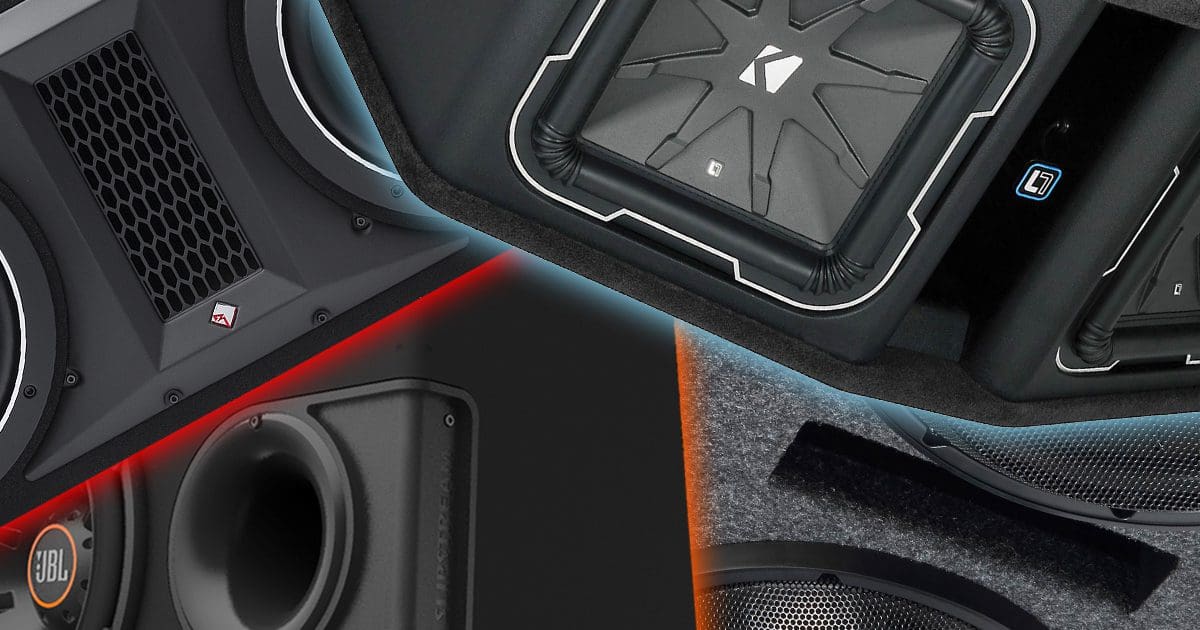When it comes to car audio bass upgrades, two options are popular: sealed and ported subwoofer enclosures. The proper names for these enclosures are acoustic suspension and bass reflex, respectively. Each has its benefits and drawbacks in reproducing low-frequency audio information in your vehicle. In this article, we’ll explain how a bass reflex enclosure works and share a few of the essential features to look for when shopping for one.
Understanding Phase and Resonance
Before we dig into how a ported subwoofer enclosure works, we need to discuss two terms: phase and resonance. Understanding these concepts is a prerequisite to understanding how a bass reflex subwoofer enclosure operates.
The term phase is used to describe the relationship between two time-based events. For example, if you are sitting at a traffic light and the turn signal on the car in front of you is turning on and off at precisely the same time as your vehicle’s, we’d describe the blinking as “in phase.” More specifically, the frequency at which the two lights are flashing is the same, and the start and stop times are the same. In reality, it’s much more likely that the turn signal blinking is a bit faster or slower than that of your vehicle. When the flashes aren’t perfectly in sync, we would describe the lights on the other vehicle as having a higher or lower frequency.
In physics, when we talk about audio waveforms, we use sine waves. All sounds we hear are comprised of sine waves at different frequencies. If the source unit, amplifier, signal processor and speakers in your car audio system are of excellent quality, a single-frequency test tone should reproduce a single sine wave. When the same tone is played in both channels of a stereo system, and the audio signals arrive at the listening position simultaneously, we describe the signals as being “in phase.”
Suppose your audio system doesn’t have a digital signal processor. In that case, the waveform produced by the speaker closest to you will arrive before that of the speaker on the opposite side of the vehicle. We don’t describe this as being “out of phase” unless one signal is at exactly the opposite polarity peak from the other. A better way to put it is to describe the signal from the closest speaker as “leading” the signal from the other source.
For a more scientific description, we use the degrees of a circle to explain the relationship between the two. A signal that leads or lags another by “180 degrees” is “out of phase,” and the two should cancel. However, signals can be at 19, 124, 350 or 293 degrees or any angle relative to another based on distance or variances in signal paths and delays. The length of a waveform from its start to finish (where it repeats) is 360 degrees.
We can also describe the differences between the signals in terms of time. If the left speaker is 2 feet closer to the listening position than the right, and both produce the same sound at the same time, we would hear the sound from the left speaker 1.78 milliseconds before the sound from the right speaker.
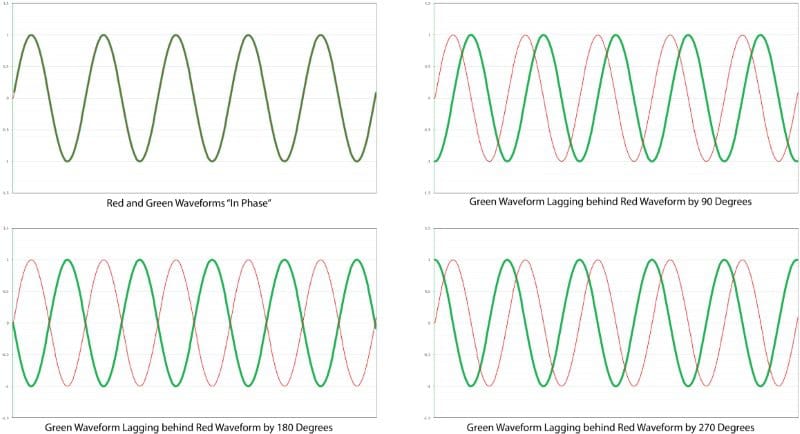
The next term we need to cover is resonance. Almost every physical structure in nature resonates. If you pluck the string of a guitar, it will resonate at a specific frequency. Tightening the tension on the string raises the resonant frequency, and loosening it lowers that frequency. If you put your finger on the string to shorten the effective length, it will resonate at a higher frequency.
Resonances happen almost everywhere. If you’ve seen a flagpole vibrate in the wind, that’s it resonating. The drone you hear from some aftermarket vehicle exhaust systems is resonance. Blowing air over the top of a partially empty pop bottle is also resonance. Similarly, a wind instrument like a flute resonates at different frequencies when the holes in the body are covered. If you’ve noticed a high-frequency peak in the measurements we’ve made of a Class D audio amplifier, that’s the output filter components resonating.
By definition, resonance refers to a mechanical (or electrical) system that vibrates or oscillates at a high amplitude when stimulated by a small signal. All moving-coil speakers have a resonant frequency. When we provide a tiny signal to the speaker at the frequency where the compliance of the suspension and the mass of the cone and voice coil resonate, we get a relatively large amount of movement.

What Is a Bass Reflex Subwoofer Enclosure?
An acoustic suspension (sealed) subwoofer enclosure is an airtight cabinet into which we install a subwoofer. The cabinet acts as a high-pass filter to limit cone excursion at low frequencies and prevents the sound coming from the back of the subwoofer from mixing with the sound coming from the front and canceling.
A bass reflex (ported) subwoofer enclosure adds a vent as a tube (or almost any shape) with a specific area and length to act as a secondary sound source. The area of the vent and its length determine the frequency at which it resonates for a given enclosure volume. Look at the pipe organ in the photograph above – it works on a very similar principle.
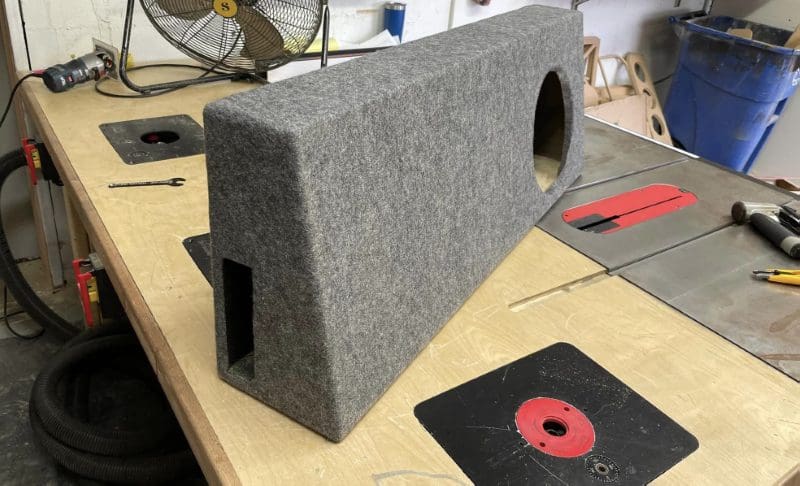
What Does the Vent in a Bass Reflex Enclosure Do?
A vent designed for a ported subwoofer enclosure has an area and length chosen to cause the system to resonate at a specific frequency – just like that pipe organ. We call this the tuning frequency of the vent. Typically, this frequency will be lower than what the driver and enclosure naturally resonate at. For example, if we were to install a Sony XS-W104ES 10-inch subwoofer in a 1.2-cubic-foot acoustic suspension enclosure, the system would have a resonant frequency of just under 60 hertz. The air in the sealed enclosure adds to the subwoofer suspension’s compliance and raises the resulting system’s natural resonant frequency. In practical terms, 1.2 cubic feet is too large to be a suitable acoustic suspension enclosure for this subwoofer, but maintaining the fixed volume simplifies this explanation.
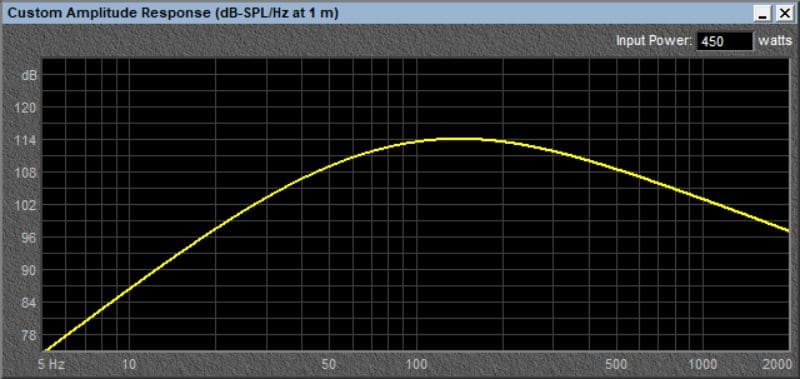
Adding a vent to the above enclosure that has an area of 7.07 square inches and a length of 11 inches results in a tuning frequency close to 35 Hz. When the subwoofer plays audio frequencies at or around that tuning frequency, the air in the vent resonates and produces output. This output adds to the output of the system and increases its efficiency. Another way to look at this would be to consider the column of air in the vent as another speaker – it moves back and forth and produces sound.
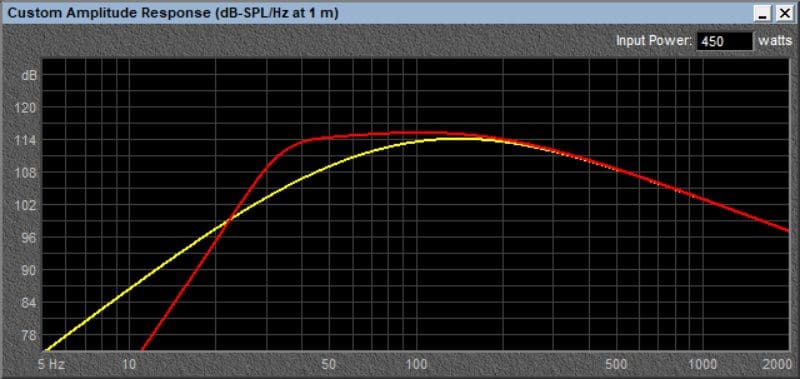
If you look at the graph above, the addition of the vent tuned to 35 hertz has increased the predicted output of the system at that frequency from 105.6 dB SPL to 112.5 dB SPL. A boost of around 7 dB is typical when comparing two well-designed enclosures. The differences vary significantly if you compare undersized enclosures or ported subwoofer enclosures with high tuning frequencies. Don’t assume that increase will always be 7 dB SPL at the tuning frequency.
What’s the Vent in a Ported Box Doing?
Here’s where phase comes into play. If everything in a bass reflex subwoofer enclosure is operating linearly, then the phase relationship between the output from the front of the driver and that of the output of the vent determines the resulting frequency response of the system. At very low frequencies, say, an octave below the tuning frequency, the output of the vent and of the driver are not in phase.
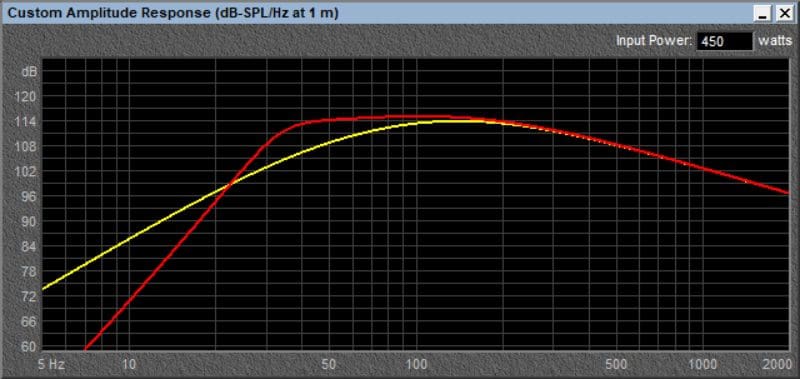
Look at the output of the system at 15 Hz. The sealed enclosure produces 93.1 dB SPL, while the bass reflex enclosure is down at 85.5 dB SPL. Below the tuning frequency, bass reflex enclosures produce less output as frequency decreases than their acoustic suspension counterparts.
The vent’s output is effectively in phase with the subwoofer at the tuning frequency. Aside from the increase in output, the vent results in an interesting pressure-based phenomenon. Imagine the operation of the vent and subwoofer in slow motion. At 35 Hz, the cone would move forward, and the column of air in the vent would also move outward. This results in a dramatic pressure decrease in the enclosure. The same happens when the cone moves rearward and the vent moves rearward simultaneously. The result is considerable pressure (and vacuum) peaks in the enclosure, dramatically reducing the speaker cone’s motion. Around the tuning frequency of a bass reflex enclosure, the subwoofer’s cone moves very little, and most of the sound from the system is produced by the vent. We can see this phenomenon if we predict the cone excursion using enclosure simulation software.
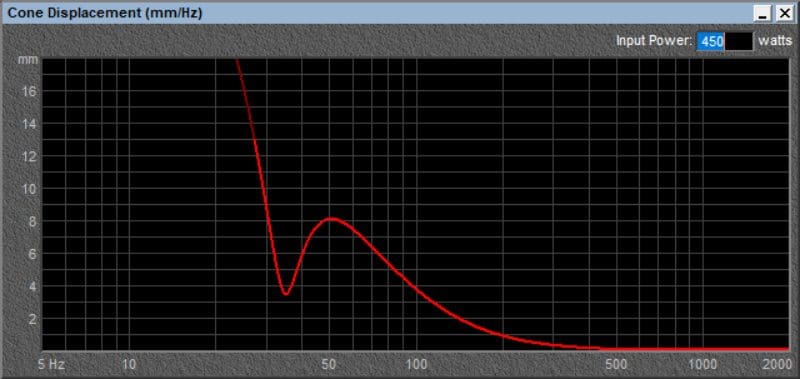
The sharp dip in the output at 35 Hz in the above graph is at the resonant frequency of the enclosure and vent (35 Hz). Remember that speaker distortion is directly proportional to cone excursion. When the vent is large enough for the excursion capabilities of the subwoofer, the dip in cone excursion around the tuning frequency has the result of dramatically reducing distortion from the subwoofer system.
OK, back to our discussion about phase and output from the vent. At frequencies above the tuning frequency, the vent and the subwoofer’s sound output remain roughly in phase. The vent output diminishes at higher frequencies, so there is less system gain at 60 or 80 hertz compared to around the tuning frequency.
A Few Thoughts on Vent Design for Ported Subwoofer Enclosures
If you’re shopping for a bass reflex enclosure for your car audio subwoofer system, there are a few things to look for. First, there is no specific guideline for how large (in terms of area) a vent should be for a particular size of subwoofer. The vent dimensions depend on the excursion capabilities of the driver, the desired tuning frequency and the volume of the enclosure. Ultimately, the goal is to minimize the air velocity in the vent so that it doesn’t make noise and add distortion.
Secondly, you want the vent to have large inner and outer edge radii, which help prevent noise and distortion from the column of air moving back and forth across a sharp corner. A 0.5-inch radius isn’t enough for a large vent and doesn’t offer much benefit in reducing noise or, as it’s often called, chuffing.
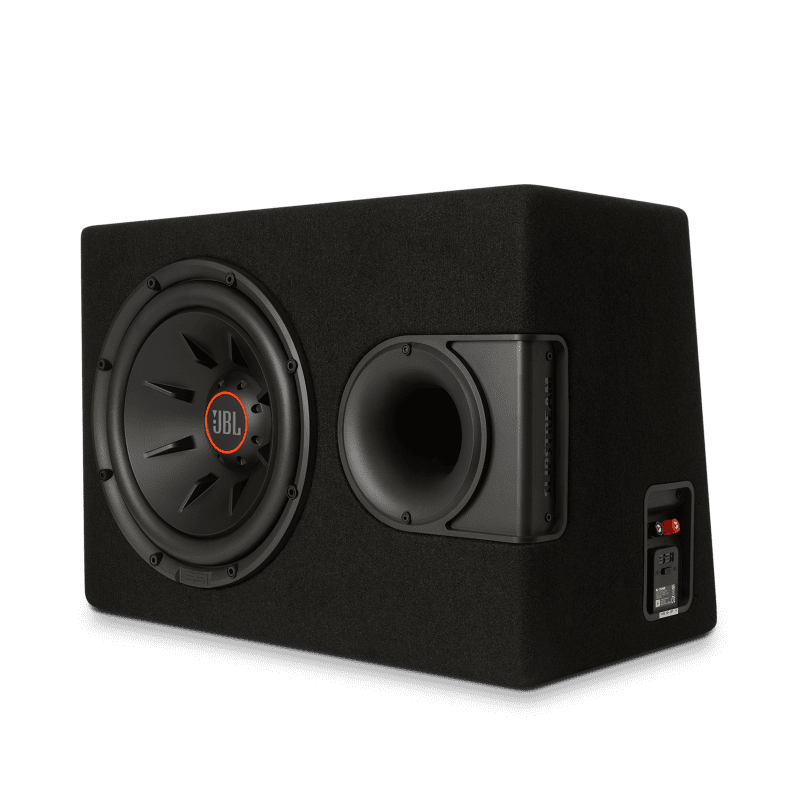
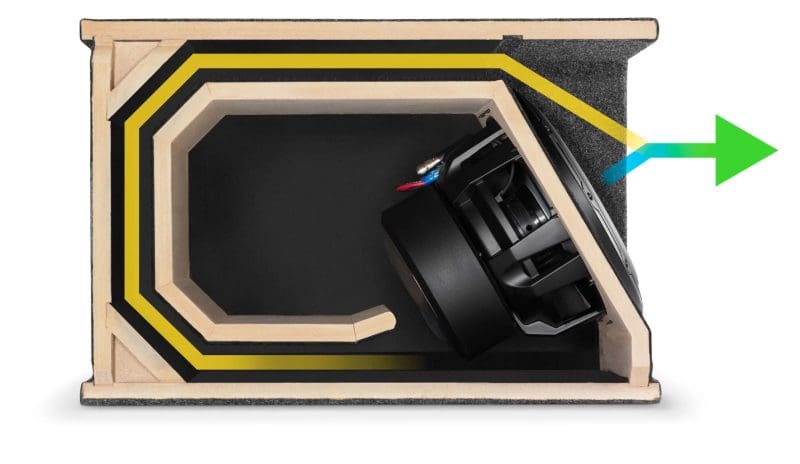
We could go on and on to discuss the benefits and drawbacks of different shapes of vents. Several scientific papers compare them, using computer-based fluid dynamic simulations. Ultimately, any quality enclosure simulation software that can calculate vent air velocity will be adequate for a custom design.
Finally, it’s essential to know that a typical ported subwoofer enclosure is significantly larger than a sealed enclosure for a given driver. With that said, a vented enclosure with a single driver will still outperform a sealed enclosure designed for two woofers, especially from 30 to 50 hertz.
Upgrade Your Car Audio System with a Ported Subwoofer Enclosure Today
If you’re shopping for a subwoofer upgrade for a car audio system, we recommend choosing a bass reflex enclosure, as it will dramatically increase the system’s efficiency. Your local specialty mobile enhancement retailer can assist you by designing a custom enclosure for your application or by offering a pre-fab solution designed for the drivers you have in mind.
